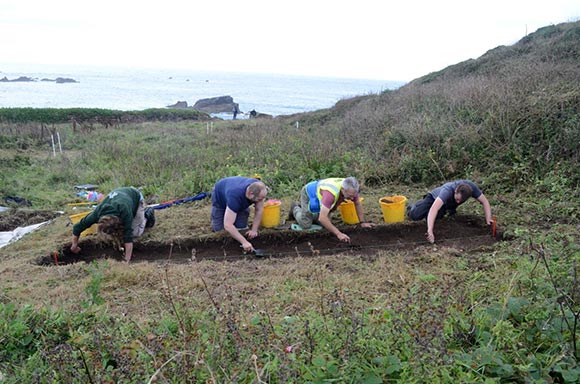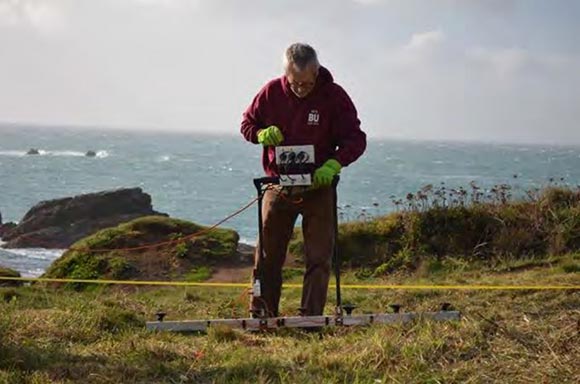Pistil Meadow and the Royal Anne
The National Trust approached MAST to help establish the veracity of contemporary sources which suggest the presence of a mass grave of crew and passengers from the wreck of an 18th century Royal Navy warship on Lizard Point in Cornwall. We have now completed work on Pistil Meadow. We believe that we have raised serious doubts regarding the truth of the legend of the burial of 200 mariners in mass graves in Pistil Meadow following the catastrophic sinking of the Royal Anne Galley in 1721, with the loss of all the some 300 crew and passengers bar three - two sailors and a boy.

Downloads
Secondary sources of the time suggest that approximately 200 bodies were buried in Pistil Meadow, victims of the wrecking of the Royal Anne Galley in 1721.
MAST, in partnership with Bournemouth University's Senior Lecturer Paul Cheetham and Associate Professor Dave Parham and Kevin Camidge of CISMAS, conducted multi-method geophysical surveys of the meadow. These have included EM conductivity, GPR and earth resistivity as well as magnetometry. The first survey was conducted in November 2012 with the aim of establishing whether any geophysical anomalies detected can be related to the reports on a number of multiple occupancy or mass graves of the victims of the wreck of the Royal Anne Galley. Owing to waterlogged ground conditions only magnetic and electromagnetic techniques were used.
In October 2014 the team returned and conducted EM, earth resistivity and GPR. The results suggest a number of clear disturbances that have the potential to result from sub-surface features that could be large graves which may relate to the burial pits reported by the historical sources. The potential for further work to confirm such an interpretation is now under discussion with the National Trust. You can read the report of our finds in the downloadable document on this page.
In the first week of September 2016 the team returned to ground-truth the anomalies from the previous surveys. The five evaluation trenches revealed buried features, but none of these were associated with any grave structures or led to the discovery of any human remains. While this does not exclude the possibility of small or individual graves being missed, it is felt that burials of the scale described in the accounts written over 120 years after the event would have been discovered during this work, leading us to conclude that the legend may have no basis in fact, being little more than romanticised invention. Accounts of the event changed with each re-telling.
In 1848 CA Johns reported the tale that there were 200 bodies buried in pits each containing between ten and thirty bodies. The story was subsequently retold by such well known authors as Wilkie Collins in 1850, who incorrectly suggested the Pistil meadow was so named because of the quantity of firearms, especially pistols, found in the meadow. By 1881 it was claimed by Mrs Crailk there were over 200 bodies of "foreign sailors" from a complement of 700, who were found with pistols in their hands. In 1948 JC Trewin, who grew up on the Lizard, changed the numbers in the burial pits to between twenty and thirty and added that the meadow has a queerness, pungent with the scent of seaweed and camomile. Daphne du Maurier in 1967 romanticised the event further by suggesting the burials may be associated with a small grove of "grotesquely shaped" windswept willow trees. That the first report stated that dogs scavenged the washed-up bodies on the beach has turned into locals believing that dogs dug up the bodies from the graves, and the area is said by locals to be haunted to this day, suggests that this process of embellishment is still underway.
These tales may contain some truth in that it is likely that there are bodies from the sinking of the Royal Anne buried in the vicinity. A contemporary newspaper account of the Board of the Admiralty enquiry into the sinking, reported that locals had rifled through some of the victim's bodies on the beach immediately following the sinking and these bodies may have well been buried in the vicinity. However, it is possible that the numbers washed up near Pistil Meadow may not have numbered anything like the claimed 200 on board, when currents and tides would likely have swept many bodies out to sea or further along the coast to be washed up and buried elsewhere.
So while he case is not quite closed, the reported 'facts' would appear to differ significantly from what actually happened after this tragic episode in British Naval history.
The full archaeological report is available as a download at the top of this page.
The story
Royal Anne Galley was a galley frigate, a small, fast warship, with combined sail and oar propulsion. She was wrecked on the Stags off Lizard Point on November 10, 1721. About 200 crew and passengers drowned in addition to her captain and Lord Belhaven, en route to take up his position as the governor of Barbados. Most of the bodies are believed to be buried in a cliff-top grave at Pistil Meadow. It is not known if Lord Belhaven’s body was taken home for burial.
The wreck site was rediscovered in 1991 by local diver Robert Sherratt when a large sounding lead was found adjacent to two iron guns. Subsequently numerous objects were recovered from the seabed in the vicinity of the guns, including cutlery bearing the Belhaven crest, which led to the identification of the wreck which was then designated under the Protection of Wrecks Act (1973) as the Royal Anne two years later.
The passage around Lizard Point is renowned for being treacherous, with over 200 recorded wrecks in the area. It is a particularly vulnerable shipping point in south westerly gales.
Until the 1808 Act of Parliament, which decreed that bodies washed ashore from shipwrecks should be interred in consecrated ground after a Christian burial, such bodies were buried, if at all, in unconsecrated ground generally close to the place of discovery.
Collaboration
MAST would like to thank Bournemouth University, the National Trust, Kevin Camidge of the Cornwall and Isles of Scilly Maritime Archaeological Society (CISMAS) and Charlie Johns of Historic Environment, Cornwall for their help in making this survey possible.






